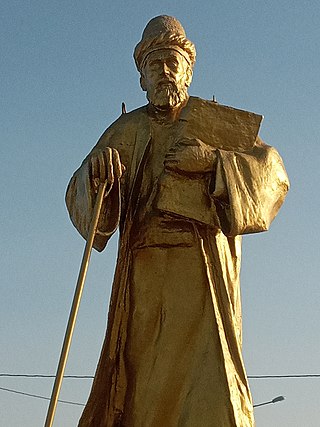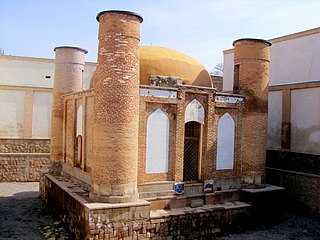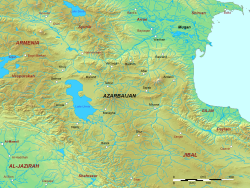
Alp Arslan was the second Sultan of the Seljuk Empire and great-grandson of Seljuk, the eponymous founder of the dynasty. He greatly expanded the Seljuk territory and consolidated his power, defeating rivals to the south and northwest, and his victory over the Byzantines at the Battle of Manzikert, in 1071, ushered in the Turkoman settlement of Anatolia. For his military prowess and fighting skills, he obtained the name Alp Arslan, which means "Heroic Lion" in Turkish.

Jalāl al-Dawla Mu'izz al-Dunyā Wa'l-Din Abu'l-Fatḥ ibn Alp Arslān, better known by his regnal name of Malik-Shah I, was the third sultan of the Great Seljuk Empire from 1072 to 1092, under whom the sultanate reached its zenith of power and influence.
Abu Talib Muhammad Tughril ibn Mika'il, better known as Tughril, was a Turkoman chieftain, who founded the Seljuk Empire, ruling from 1037 to 1063.

Abu Shuja Ghiyath al-Dunya wa'l-Din Muhammad ibn Malik-Shah, better known as Muhammad I Tapar, was the sultan of the Seljuk Empire from 1105 to 1118. He was a son of Malik-Shah I and Taj al-Din Khatun Safariya. In Turkish, Tapar means "he who obtains, finds".

Abū Ja'far Abdallah ibn Aḥmad al-Qādir (Arabic: أبو جعفر عبد الله بن أحمد القادر) better known by his regnal name al-Qā'im bi-amri 'llāh or simply as al-Qā'im; 1001 – 2 April 1075) was the Abbasid caliph in Baghdad from 1031 to 1075. He was the son of the previous caliph, al-Qadir. Al-Qa'im's reign coincided with the end of the Buyid dynasty's dominance of the caliphate and the rise of the Seljuk dynasty.

Maragheh is a city and capital of Maragheh County, East Azerbaijan Province, Iran. Maragheh is on the bank of the river Sufi Chay. The population consists mostly of Iranian Azerbaijanis who are bilingual in Azerbaijani and Persian. It is 130 kilometres (81 mi) from Tabriz, the largest city in northwestern Iran.

The Shaddadids were a Kurdish Sunni Muslim dynasty. who ruled in various parts of Armenia and Arran from 951 to 1199 AD. They were established in Dvin. Through their long tenure in Armenia, they often intermarried with the Bagratuni royal family of Armenia.

Qatran Tabrizi was a Persian writer, who is considered to have been one of the leading poets in 11th-century Iran. A native of the northwestern region of Azarbaijan, he spent all of his life there as well as in the neighbouring region of Transcaucasia, mainly serving as a court poet under the local dynasties of the Rawadids and Shaddadids.

Alid dynasties of northern Iran or Alavids. In the 9th–14th centuries, the northern Iranian regions of Tabaristan, Daylam and Gilan, sandwiched between the Caspian Sea and the Alborz range, came under the rule of a number of Arab Alid dynasties, espousing the Zaydi branch of Shia Islam.

Rawwadid or Ravvadid or Banū Rawwād (955–1071) was a Sunni Muslim Kurdish dynasty, centered in the northwestern region of Adharbayjan (Azerbaijan) between the late 8th and early 13th centuries.

The Sallarid dynasty, was a Muslim dynasty, of Daylami origin, which ruled in Tarom, Samiran, Daylam, Gilan and subsequently Azerbaijan, Arran, and some districts in Eastern Armenia in the 2nd half of the 10th century. They constitute part of the period in history that has been named the Iranian Intermezzo, a period that saw the rise of native Iranian dynasties during the 9th to the 11th centuries.

Abu'l-Aswar or Abu'l-Asvar Shavur ibn Fadl ibn Muhammad ibn Shaddad was a member of the Shaddadid dynasty. Between 1049 and 1067 he was the eighth Shaddadid ruler of Arran from Ganja. Prior to that, he ruled the city of Dvin from 1022 as an autonomous lord. A capable warrior, and a wise and cunning ruler, Abu'l-Aswar was engaged in several conflicts with most of his neighbours. During his rule over Dvin, he was mostly involved in the affairs of the Armenian principalities. He collaborated with the Byzantine Empire in its conquest of the last remnants of Bagratid Armenia in 1045, but when the Byzantines later turned on him, he survived three successive offensives that sought to take Ganja. In 1049, a revolt in Ganja overthrew his infant great-great-nephew, Anurshirvan. The rebels invited him to take up the family's emirate, and he moved from Dvin to Ganja. Under his rule, the Shaddadid dynasty reached its zenith. He undertook successful campaigns into Georgia and Shirvan, although the limits of Shaddadid power were exposed by his failure to take over the Emirate of Tiflis and by devastating raids by the Alans. At the same time, his reign witnessed the rapid rise of the Seljuk Empire and the extension of its control over the Transcaucasian principalities. Abu'l-Aswar became a Seljuk vassal in 1054/5. Although he gained control over the former Armenian capital of Ani through Seljuk patronage in 1065, this association also paved the way for the dynasty's decline after his death in November 1067.

The Great Seljuk Empire, or the Seljuk Empire was a high medieval, culturally Turko-Persian, Sunni Muslim empire, founded and ruled by the Qïnïq branch of Oghuz Turks. It spanned a total area of 3.9 million square kilometres from Anatolia and the Levant in the west to the Hindu Kush in the east, and from Central Asia in the north to the Persian Gulf in the south.

Amid al-Mulk Abu Nasr al-Kunduri, commonly known as al-Kunduri, was a Persian bureaucrat, who served as the vizier of the first Seljuk Sultan Tughril and his nephew Alp Arslan.
Wahsudan ibn Muhammad was the Sallarid ruler of Daylam (941/2–967). He was the son of Muhammad bin Musafir, the ruler of Tarum.
Ibrahim I ibn Marzuban I was the Sallarid ruler of Dvin (957–979) and later Azerbaijan. He was the son and successor of Marzuban ibn Muhammad.
Abu Muhammad al-Hasan al-Yazuriibn Ali ibn Abd al-Rahman was a vizier of the Fatimid Caliphate, holding office from 1050 to 1058.

Abu Nasr Mamlan II was the last Rawadid amir (ruler) of Azarbaijan from 1058/9 to 1071. He was the son and successor of Abu Mansur Wahsudan. He was along with his sons arrested in 1070 by his suzerain, the Seljuk ruler Alp Arslan, thus marking the end of the Rawadid dynasty. However, their descendants, the Ahmadilis, recaptured Maragha in the early 12th-century.
Abu Nasr Husayn II was the supposed Rawadid amir (ruler) of Adharbayjan from 1001 to 1025. A son of the Rawadid amir Abu'l-Hayja Mamlan I, Abu Nasr Husayn II's regnal period is disputed in scholarship.
Muhammad ibn Husayn al-Rawadi was the founder of the Rawadid dynasty, ruling parts of Armenia and Azarbaijan in the mid 10th-century. He was succeeded by his son Abu'l-Hayja Husayn I between 953–956.















